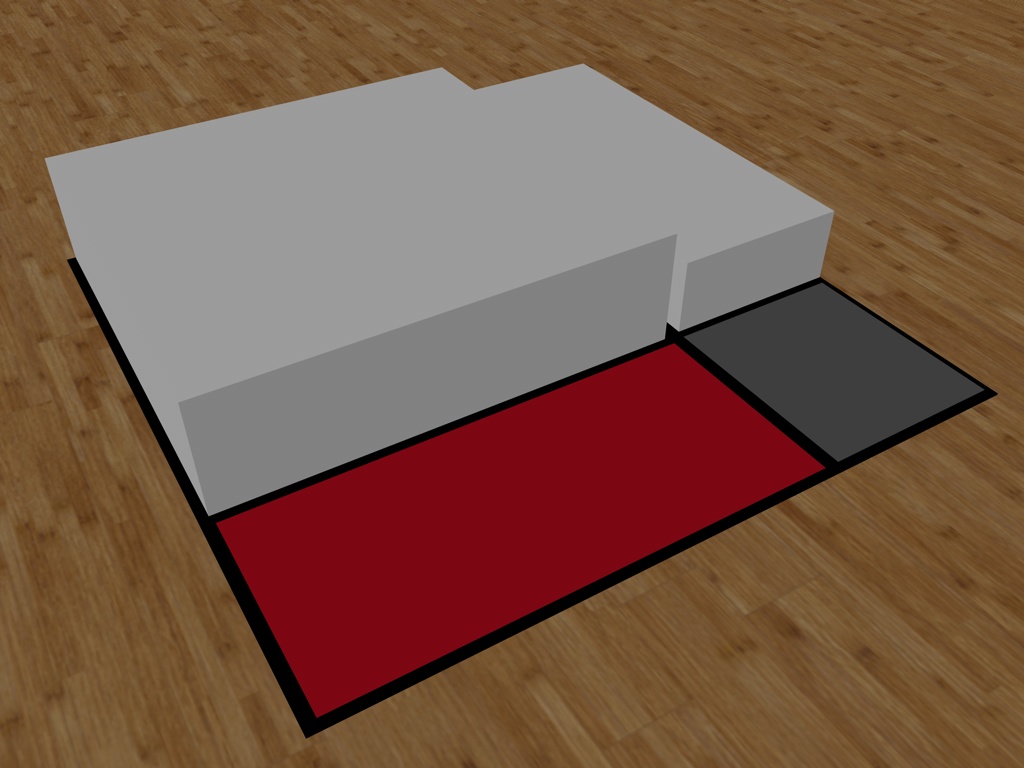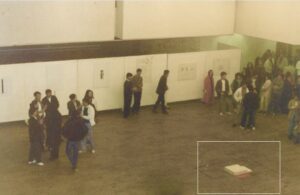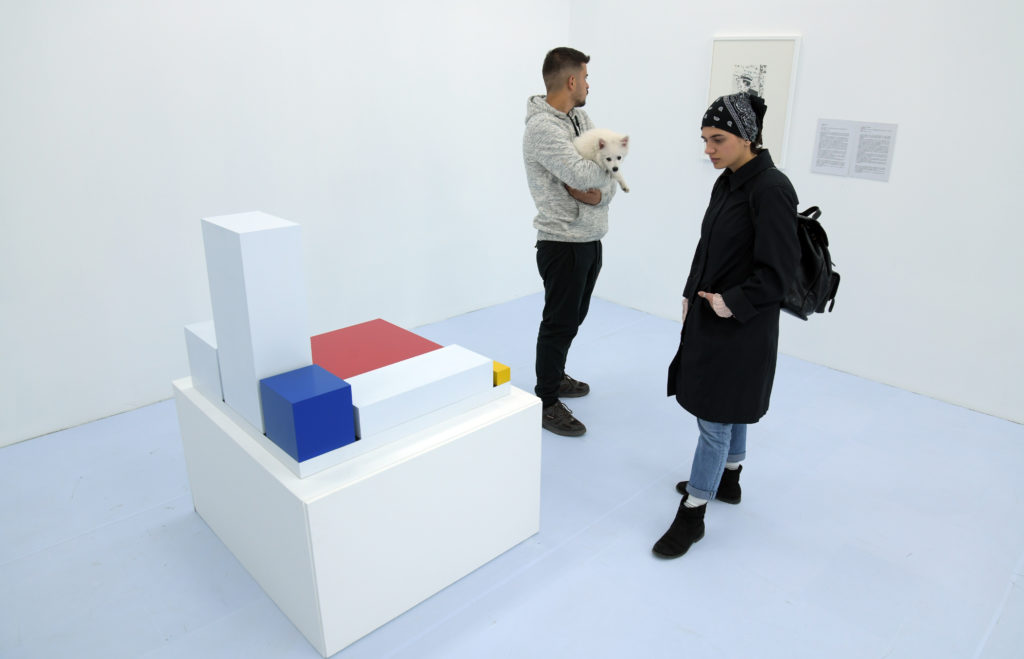Neoplasticism in space, 1985, FILOART, Exhibition View, 1986, Pallati i Rinisë, Prishtinë
This work, through questioning the meaning of dimensions and perspectives manages to open a different view to the “linear” and “non-linear” developments in the history of art.
At a glance from a distance this work gives the impression of an urbanistic architectonic model. Getting closer to the work we start to recognize something familiar to us, but not in this form and situation.
All neoplasticism works by Mondrian are two-dimensional and normally they hang (on the walls).
In “Neoplasticism in Space” something unusual occurs.
From the two dimensional cited work of Mondrian, it looks like two rectangles start losing their gravity. Two white cubes rise from the two white rectangles.
The work changes from surface to form, from a painting to an architectonic object. The work lies on the ground, it doesn’t hang on the wall, so it changes the complete perception of the observer, who is used to observing Mondrian’s work from the horizontal (normal-hu- man) view (perspective). In this case, the observer looks at the object, from the “bird’s-eye view” (perspective).
Neoplasticism
What was on Mondrian’s mind, while he was in the process of “reducing” his entire work to two dimensions?!
Why would somebody “give up” on the human achievements, the knowledge of the technique (how to draw / paint / think) in three dimensions and “turn back” to the abstract two dimen- sional world?
What could be the reason? Was the reason to search further? Further in the canvas, or further in the mind or both?
Did he paint something that was closer to the “truth” and “reali- ty” than any other (art) works before?
What kind of act is to take a three dimensional object as a “model” and paint or draw in two dimensions, on a two dimen- sional surface? Is it something illogical? A painting is always two dimensional. We only imagine the third dimension in the painting or drawing. So did Mondrian still remove a non-existent dimension from the painting?
Neoplasticism in Non-Space
Had FILOART continued following Mondrian’s working principle and “left out” one dimension, we would now have before us a one-dimensional work.
(Suppose that FILOART could make a one-dimensional work. How would it look and how would we call that act at all? )
This didn’t happen! On the contrary, in “Neoplasticism in Space”, Mondrian’s cited work got another dimension.
Let’s analyze this transformation process. Suppose that Mon- drian transformed and removed one dimension from his work. Then take the same (transformed) work in two dimensions and transform it again into a three dimensional work.
Can we say that this is the case in our example? Can we say that Mondrian’s “model” previously looked like this work (“Neoplas- ticism in Space”)? Definitely not!
But can we say that this work (“Neoplasticism in Space”) is a neoplastic work which went through a transformation from two dimensions to three? Yes, of course. Indirectly, they are connected with each other.
But what is the end result and what does that work look like?
If Mondrian’s act is one logical act (which it is), what kind of act is this?
Is this work illogical, counter-evolutional, a step backward?
Is this step illogical? No, because there are countless of exam- ples, where shapes/objects take form from two dimensions to three. Counter-evolutional? This work evolved from Neoplas- ticism. A step backward? We cannot say, because this work doesn’t have the same starting point as Mondrian’s work. So, if is not a continuation of Mondrian’s work, and it’s not the oppo- site of it, what then is this work? Could it even belong to a linear development of (art) history if, there is such a thing? If we take Mondrian’s work and place it in the period when it was made, and compare it to the other works of that time, we can come to the conclusion that his work cannot belong to a “linear” devel- opment of art history.
Did he change the flow of art history with his act? Does this act make art history non-linear? Is this nonlinear step, a step “back” or a radical step forward? (These same questions could have been raised in the case of Kazimir Malevich!)
So if Mondrian’s work is non-linear, where does “Neoplasticism in space” belong, if it belongs anywhere at all? Maybe we can place this work to affect, as an oscillator work in the History.
 3D Reconstruction of “Neoplasticism in space” made by Activists, 2013
3D Reconstruction of “Neoplasticism in space” made by Activists, 2013
Neoplasticism in space, 1985, FILOART, from the Exhibition Metaxyum Grouping Moving Spreading, W.A.S., National Gallery of Kosovo, 2019
____________________
*The work Neoplasticism in space took one of the central positions in the presentation “This is not an exhibition but the opposite of it” 1987.
**This work was first presented at the “Congress of Students of Architecture” 1986 in Zagreb in front of the Croatian National Theatre

